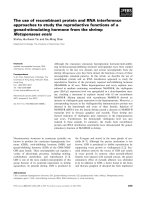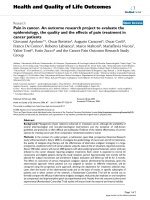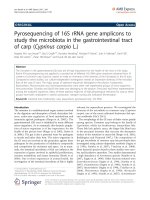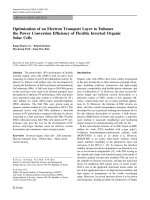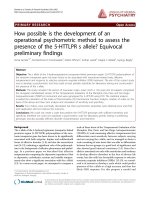Effect of packaging materials and temperature on post-harvest life of Gladiouls cv. punjab dawn
Bạn đang xem bản rút gọn của tài liệu. Xem và tải ngay bản đầy đủ của tài liệu tại đây (114.62 KB, 5 trang )
Int.J.Curr.Microbiol.App.Sci (2018) 7(8): 889-893
International Journal of Current Microbiology and Applied Sciences
ISSN: 2319-7706 Volume 7 Number 08 (2018)
Journal homepage:
Original Research Article
/>
Effect of Packaging Materials and Temperature on Post-harvest Life of
Gladiouls cv. Punjab Dawn
Anjana Sisodia*, Priyanka Kumawat, Minakshi Padhi and Anil K. Singh
Department of Horticulture, Institute of Agricultural Sciences,
Banaras Hindu University, Varanasi-221005, U.P., India
*Corresponding author
ABSTRACT
Keywords
Gladiolus,
Packaging
materials,
Temperature, Postharvest life
Article Info
Accepted:
08 July 2018
Available Online:
10 August 2018
An experiment was conducted to study the effect of temperature and different packaging
materials on post-harvest life of gladiolus spike at Post-harvest Laboratory, Department of
Horticulture, Institute of Agricultural Sciences, Banaras Hindu University, Varanasi,
during the year 2017. Experiment was laid out in Completely Randomized Design with
three replications. The results revealed that gladiolus spike stored at 16ºC (cool chamber
condition) and 22 ± 2ºC (ambient condition) failed to exert any significant effect on days
to open of third and fifth floret, percentage of opened florets, diameter of fifth floret and
length of fifth floret. Maximum diameter, days to withering of first and third florets,
weight of spike at third, sixth and ninth day and shelf life was recorded with cellophane
paper packaging. There was no any significant difference between ambient (22 ± 2ºC) and
cool chamber condition (16ºC) on weight of spike at third, sixth and ninth day, days to
withering of first and third floret and shelf life of spike. Whereas, maximum length of first
floret was observed with spike packed in news paper. Spikes stored in cool chamber
resulted in maximum days to withering of fifth floret.
Introduction
Gladiolus is a high value crop among cut
flowers. The fascinating spikes bear a large
number of florets with varying sizes and forms
with smooth ruffled or crinkled tepals (Singh,
2006). Storage extends the marketing season
and regulates marketing in times of glut
production. Appropriate method of storing
flowers offers the possibility of long term
shipment (Jain et al., 2006). Cut flower
longevity depends on the carbohydrate
reserves of flowers, osmotic concentrations
and pressure potential of petal cells, stomatal
functioning, variation in stem diameter and
rigidity, differences in the number of thick
walled supporting cells in the xylem elements
and phloem fiber, lignifications and level of
plant hormones and vulnerability of diseases
and pests (Bhattacharjee, 1999). Use of
packaging materials increases the vase life of
flowers. Different type of packaging materials
can be used to extend the shelf life of flowers
viz., news paper, butter paper, cellophane
paper, plastic bags, CFBoxes, etc. which help
in slow opening of florets. They reduce the
amount of production of O2 and increase the
production of CO2. This mechanism checks
889
Int.J.Curr.Microbiol.App.Sci (2018) 7(8): 889-893
the metabolic process of flowers which
prolongs the shelf life of flowers. Low
temperature helps in reducing the amount of
ethylene, which is responsible for quality
improvement and increase storage life of
gladiolus spikes. Cut spikes of gladiolus do
not store well under refrigerated condition for
long duration. The spike could also be stored
under controlled atmosphere (CA) storage in
poly propylene sleeves with 2% and 5% O2
and CO2, respectively for about 15 days
(Singh, 2006). Therefore, an experiment was
conducted to study the effect of various
packaging materials and different temperature
on post-harvest life of cut gladiolus spikes cv.
Punjab Dawn.
Materials and Methods
The corms of gladiolus cv. Punjab Dawn were
raised at Horticulture Research Farm, Institute
of Agricultural Sciences, Banaras Hindu
University, Varanasi, Uttar Pradesh following
standard cultural practices. The experiment
was carried out in the Post-harvest Laboratory,
Department of Horticulture during the year
2017. Spikes were harvested in early morning
when three lower florets show colour.
A slant cut was given with the help of a sharp
knife as close to the base. After harvesting, cut
spikes were kept in a bucket containing water
and immediately brought to the laboratory for
post-harvest studies. All the leaves were
removed and again a cut was given to the
spikes with the help of a sharp knife. Standard
length of spike was maintained. After
weighing fresh weight and measuring length
of spikes, the spikes were kept in envelops of
different packaging materials viz., blotting
paper, brown paper, butter paper, cellophane
paper and news paper. Envelops were put in
cardboard boxes and placed at different
temperature conditions. Observations were
recorded on various post-harvest attributes and
data were analyzed statistically.
Results and Discussion
Gladiolus spike stored at 16ºC (cool chamber
condition) and 22 ± 2ºC (ambient condition)
failed to exert any significant effect on days to
open of third and fifth floret, percentage of
opened florets, diameter of fifth floret and
length of fifth floret. However, significantly
slow opening was observed under cool
chamber condition (16ºC). Similarly, lesser
diameter of first and third floret was observed
under cool chamber condition (22 ± 2ºC). Low
temperature helps to reduce the amount of
ethylene and decrease the rate of respiration,
which is responsible for flower opening.
Therefore, rate of opening of florets was found
slow in cool chamber condition (16ºC). Beura
and Singh (2003) and Grover et al., (2005)
were also found same results. Various
packaging materials failed to give any
pronounce effect on days to fifth floret
opening, percentage of opened floret, diameter
of fifth floret and length of third and fifth
floret. However, there was significant effect of
different characters due to various packaging
materials (Table 1). Late opening of first floret
was observed with news paper, brown paper,
butter paper and even control in comparison to
cellophane paper. However, third floret was
opened late in the spike packed in brown
paper followed by news paper. Fast opening of
third floret and maximum diameter of first and
third florets were observed in cellophane
paper
packaging.
However,
it
was
significantly minimum with packaging of
spikes in brown paper. Maximum length of
first floret was observed with spike packed in
news paper which was significant to
packaging of spike in butter paper. This might
be due to the wrapping with polypropylene
sheet, makes the microenvironment become
rich in CO2 with less O2, thus might have
reduced the rate of respiration as well as
inhibiting ethylene action (Munsi et al., 2011).
890
Int.J.Curr.Microbiol.App.Sci (2018) 7(8): 889-893
Table.1 Effect of temperature and packaging materials on days to opening of floret, percent of opened florets, diameter of floret and
length of floret in post-harvest life of gladiolus cultivar Punjab Dawn
Temperature
Ambient condition (22±2ºC)
Cool chamber condition (16ºC)
CD at 5%
Packaging material
Control
Blotting paper
Brown paper
Butter paper
Cellophane paper
News paper
CD at 5%
Days to opening of floret
First
Third
Fifth
floret
floret
floret
3.50
4.44
4.11
3.11
4.33
5.22
0.36
NS
NS
3.50
3.33
3.50
3.50
2.50
3.50
0.63
4.33
4.17
5.50
4.17
3.50
4.67
0.89
%of
opened
florets
46.89
45.96
NS
4.67
4.50
5.83
4.17
4.17
4.67
NS
44.48
51.65
40.81
45.38
50.21
46.03
NS
Diameter of floret (cm)
First
Third
Fifth
floret
floret
floret
6.74
7.02
4.82
6.26
6.19
5.26
0.29
0.28
NS
Length of floret (cm)
First
Third
Fifth
floret
floret
floret
8.08
7.43
5.08
7.37
6.28
5.98
0.52
0.46
NS
6.45
6.57
5.97
6.73
7.17
6.10
0.51
8.10
7.87
7.40
6.50
8.18
8.30
0.89
6.58
6.73
6.17
6.68
7.25
6.23
0.48
5.08
5.53
4.87
4.18
6.50
4.05
NS
6.40
7.10
7.48
6.50
6.55
7.10
NS
5.12
6.17
5.77
4.25
7.02
4.85
NS
Table.2 Effect of temperature and packaging materials on weight of spike, days to withering of floret and shelf life in post-harvest life
of gladiolus cultivar Punjab Dawn
Temperature
Ambient condition (22±2ºC)
Cool chamber condition (16ºC)
CD at 5%
Packaging material
Control
Blotting paper
Brown paper
Butter paper
Cellophane paper
News paper
CD at 5%
Weight of spike (g)
Third
Sixth day
Ninth
day
day
Days to withering of floret
First
Third
Fifth
floret
floret
floret
32.44
33.17
NS
29.52
30.68
NS
25.48
26.66
NS
2.83
3.00
NS
4.33
4.56
NS
2.83
4.28
1.27
8.22
8.44
NS
32.18
31.77
33.32
29.74
37.29
32.53
4.30
28.32
28.63
30.78
26.46
36.74
29.69
4.00
21.76
25.10
26.04
21.94
36.16
25.41
3.72
2.50
2.50
2.17
3.17
4.17
3.00
0.92
3.83
4.17
4.50
4.83
5.83
3.50
1.41
3.83
4.17
3.00
2.50
5.50
2.33
NS
6.83
8.33
8.33
8.33
9.17
9.00
0.98
891
Shelf life
(days)
Int.J.Curr.Microbiol.App.Sci (2018) 7(8): 889-893
Similar result was lent credence with the
finding of Reddy (2016) in tuberose. There
was no any significant difference between
ambient (22 ± 2ºC) and cool chamber
condition (16ºC) on weight of spike at third,
sixth and ninth day, days to withering of first
and third floret and shelf life of spike.
However, spikes stored in cool chamber
resulted in maximum days to withering of
fifth floret which was significantly higher
than ambient condition.
References
Ahmad, I., Dole, J.M., Saleem, M., Khan,
M.A., Akram, A. and Khan, A.S.
(2013). Preservatives and packaging
material have an impact on the postharvest longevity of cut Rosa hybrida
L. Kardinal flowers. The Journal of
Horticultural
Science
and
Biotechnology, 88(3): 251-256.
Beura, S. and Singh, R. (2003). Effect of
storage temperature and wrapping
material on post-harvest life of
gladiolus cultivar Her Majesty.
Journal of Ornamental Horticulture,
6(4): 322-327.
Bhattacharjee, S.K. (1999). Research on
agrotechnology in roses at IARI, New
Delhi. Indian Rose Annual, 15: 80-86.
Grover, J.K., Gupta, A.K., Singh, K. and
Brar,
J.S.
(2005).
Modified
atmosphere packaging of cut flowers
in polymeric films-suitable technology
for India. Proce: International
Conference on Plasticulture and
Precision Farming. New Delhi, India,
17-21 November, p. 258.
Jain, R., Bhalla, R., Gupta, Y.C., Thakur, K.S.
and Thakur, R. (2006). Effect of
wrapping material and dry storage on
postharvest quality of rose cv. First
Red cut flowers. Journal of
Ornamental Horticulture, 9(3): 192195.
Munsi,
P.,
Chakrabarty,
S.
and
Roychowdhury, N. (2011). Effect of
storage conditions and packaging
supplemented with different solutions
(wet packing) on vase life of gladiolus.
Acta Horticulturae, pp. 351-357.
Naz, S. (2003). Effect of different packing
materials on the post-harvest life of
rose. Journal of Research Science,
14(2): 187-192.
Palanikumar, S. and S.K. Bhattacharjee
(2001). Effect of wet storage on post-
Maximum weight of spike at third, sixth and
ninth day was observed with spikes stored in
cellophane paper followed by brown paper
and news paper treatments. Significantly
lower weight of spike was recorded with
control condition. Maximum days taken to
withering of first floret were recorded with
spikes placed in cellophane paper which was
statistically higher than other packaging
materials. Similarly, maximum days taken to
withering of third floret were recorded with
cellophane paper which was statistically at
par with butter paper and brown paper
treatments and significant to news paper,
blotting paper and control. Cellophane paper
treatment was also resulted in longest shelf
life of spikes, found significantly higher than
control, which was at par with other
treatments and significant to control. In
cellophane paper there is no source of air
motion therefore, reduction in weight of spike
observed low due to low rate of respiration.
Freshness of florets remain for longer
duration due to less water loss from
cellophane paper packed spike, therefore,
withering of floret takes longer duration in
spikes packed with cellophane paper.
Cellophane paper packed spikes at low
temperature condition was found significant.
Palanikumar and Bhattacharjee (2001),
Zeltzer et al., (2001), Naz (2003), Jain (2006)
and Ahmad et al., (2013) were found similar
results in rose.
892
Int.J.Curr.Microbiol.App.Sci (2018) 7(8): 889-893
harvest life and flower quality of cut
roses.
Journal
of
Ornamental
Horticulture, 4(2): 87-90.
Reddy (2016). Effect of post-harvest dipping,
packaging and storage temperatures on
keeping quality of loose flowers of
tuberose (Polianthes tuberosa L.).
M.Sc. Thesis, College of Horticulture,
Rajendranagar, Hyderabad Dr. Y.S.R.
Horticultural University.
Singh A.K. (2006). Flower Crops: Cultivation
and
Management,
New
India
Publishing Agency, New Delhi, India.
p. 447.
Zeltzer, S., Meir, S. and Mayak, S. (2001).
Modified
atmosphere
packaging
(MAP) for long- term shipment of cut
flowers. Acta Horticulturae, 553: 631634.
How to cite this article:
Anjana Sisodia, Priyanka Kumawat, Minakshi Padhi and Anil K. Singh. 2018. Effect of
Packaging Materials and Temperature on Post-harvest Life of Gladiouls cv. Punjab Dawn.
Int.J.Curr.Microbiol.App.Sci. 7(08): 889-893. doi: />
893


